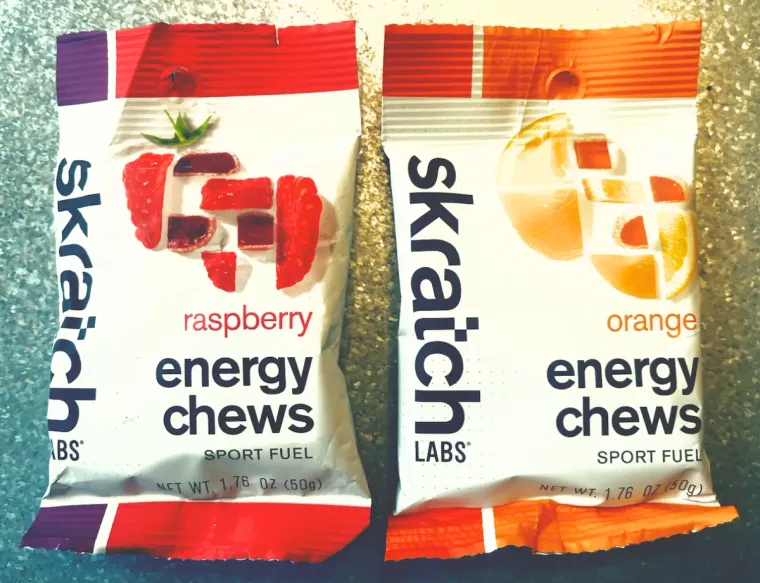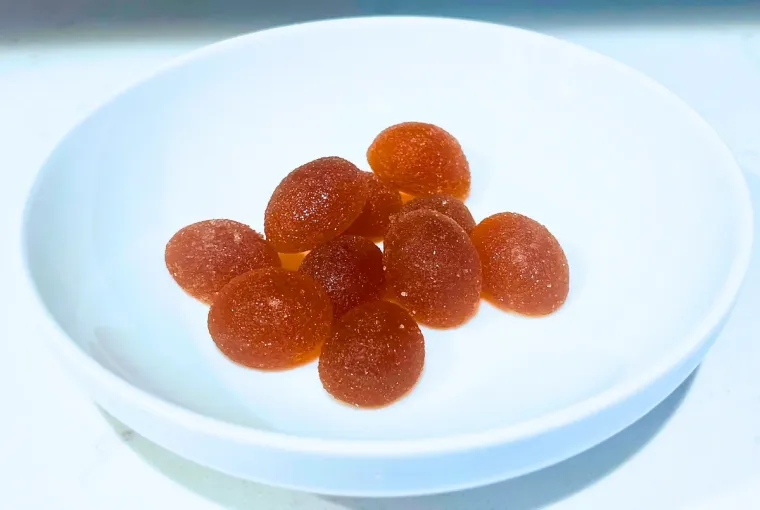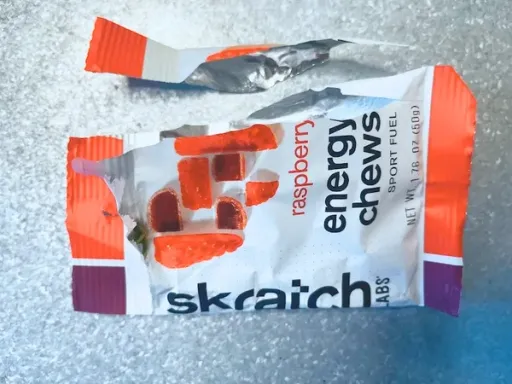Energy Chews for Racing: Do They Actually Work?

- Runners dialing in their marathon and ultra nutrition
- Energy-chew-curious triathletes
- Endurance athletes experimenting with sports nutrition products

IN THIS ARTICLE
After a summer dominated by short-course triathlons, I swapped tri-specific training for a healthy dose of autumn trail running.
With hot and humid summers in Southern Illinois, fall is the best ti
me for the sport in the Midwest. It's also the perfect backdrop for my last year-end challenge: a winter trail marathon.
I like having an event on my calendar. It provides a specific training objective. For me, that objective involved logging plenty of time running on single-track trails in the woods. For anyone wondering - attempting a trail marathon without proper off-road training is a recipe for race-day suffering.
I finished the race a few weeks ago - it went exceptionally well until it went exceptionally bad.
I attribute the performance to two factors:
- Poor pacing (mainly this)
- A new nutrition strategy: racing with energy chews

All races present opportunities to test new strategies. Learning what works and what doesn't is part of the process.
With that said, it's also possible to learn from the first-hand experiences of others.
If you're planning to race with energy chews for an upcoming running event, keep reading. Racing with energy chews isn't always a winning strategy.
Training with Energy Chews
I'm a heavy, salty sweater. I gravitate towards calorie-dense gels and hydration mixes. I just started trying out energy chews this year. I've tried a handful of brands, but I'm still surveying the landscape.
Try Energy Chews Before Racing with Energy Chews
If it ain't broke, don't fix it.
Last-minute nutrition plan tweaks can shatter months of consistent training and preparation. The potential consequences of experimenting with nutrition on race day far outweigh the potential benefits. That is unless you're eager to tour the course's portable toilets (best case) or dive into a bush just off the trail. I'll leave the worst outcomes to your imagination.
All of this is to affirm: trying out novel nutritional strategies during a race is a terrible idea.
Experiment with nutrition during training. Make your gut's biome an endurance sports science test bed for the latest and greatest high-carb garb. Test all of the chews, GUs, and gels that you want during training.
How I Try Out Endurance Nutrition & Hydration Products

I occasionally fall victim to the promises of endurance nutrition marketing hype. Online advice suggests, "Try a bunch of energy gels to figure out which products works best for your stomach."
I use a liberal interpretation of this sage advice, routinely giving myself permission to purchase a small collection of seemingly random endurance nutrition products to try out on training runs and rides.
When testing new nutrition products on training runs, I generally pair something new with something old. I encourage athletes to do the same. Test your new nutrition and hydration products in isolation.
Treat your gut like a science experiment - introduce a single variable at a time, and see how it works. If you test several unfamiliar products simultaneously, a single disagreement might ruin the entire session, and you won't know which product is responsible for any stomach issues.
It's also a good idea to try new energy gels, chews, or hydration mixes in different conditions. If you're training for an endurance event, your training will likely span several months. This takes you through different seasons and exposes you to different environmental conditions. Climate and geography differ too - incorporate your race-day nutrition into your training as much as possible to avoid gastrointestinal upsets.
My hydration needs are drastically different when I'm training on a hot Midwest day.
On a hot, humid summer day, I can endlessly down hydration mix. This makes it easy to get liquid calories, which lessens the need to supplement with energy bars, gels, or chews.
It's harder to consume as many liquid calories when racing a winter trail marathon, where conditions will be below freezing. Hot races demand fluid and electrolyte replacement to maintain performance. The hydration requirements for a fall or winter trail marathon are considerably less than one under the blazing summer sun.
Microdosing Carbs with Skratch Labs Sport Energy Chews
I had the chance to visit the Skratch Labs Cafe during my last visit to Boulder, Colorado. Their products are popular with cyclists, and I've used their sports drink mix for a long time. But it wasn't until I tried the Cafe's burrito that I gave their solid endurance fueling options proper consideration.
While Skratch's energy chews taste nothing like their cafe's burrito, I think they're tasty. That's important if you plan to consume dozens of them over a multi-hour event.

Each Skratch energy chew package has 10 gummies. The entire package has 160 calories. An individual gummy has about 16 calories and 4 grams of carbs.
With 60 minutes in an hour and 10 gummies in a package, the decision to experiment with carb microdosing is obvious. With such small, bite-sized servings, it's easy to control how much fuel you're consuming.
I normally train and race with energy gels, which contain 80+ calories and 20g+ of carbs per serving. The gels spike the available fuel in the body, and the lump serving is harder for the body to digest during hard efforts. By microdosing the energy chews, I hypothesized that I could fine-tune my carb supplementation during training and racing.
I ate 1 gummy every 6 minutes, and I maintained this as closely as I could for the duration of my training plan's long-distance runs. I also experimented with eating 2 gummies every 12 minutes.
I found that microdosing energy chews work well during training. The granular caloric intake provides a consistent fuel source for the body. The carb microdose "drip" allowed me to sustain consistent energy levels for the entirety of my long run.
I maintained this strategy for a handful of longer runs throughout my training. I didn't encounter any GI distress, even on runs up to three hours in duration. Though, I will add, after a couple of hours I found that the idea of consuming more gummies became less and less appetizing. I can't proclaim that the Skratch Labs chews taste great, but they do claim natural ingredients and a big enough variety of flavors to keep them somewhat interesting during longer-runs.
I can tolerate the chews after a few hours, but they become less appealing with each gummy. I recommend ultrarunners avoid relying solely on chews. It might be hard for your taste buds tolerate a strict energy chew diet for anything longer than a 50k run.
Skratch Labs Alternatives: Clif Bloks and Honey Stringer Chews
I haven't incorporated either of these into my training or racing. But, if you're not a fan of the Skratch Labs energy chew. Track down a few packages of Clif Bloks Energy Chews or Hone Stinger Energy Chews. They seem reputable and popular with athletes.
Racing with Energy Chews
Before racing with energy chew, consider the course.
The trail marathon course that I ran was nothing like a road marathon.
The trail marathon that I registered for winds and weaves alongside river bluffs and rocky, root-laden trails. The trails are technical. They require persistent mental presence to avoid falling.
Even though the marathon course lacks significant climbs, it still packs nearly 2,000 feet of vertical gain. The course's lowest point is only a couple hundred feet below the peak. This means there are a lot of ups and downs. So, what the course lacks in sustained climbs it makes up for in a consistent transition from running uphill to running downhill.

Positives
- Avoided any GI distress, racing with energy chews works with my digestive system
- Provides a quick, controlled energy boost
- Great alternative if gels don't groove with your stomach
Negatives
- Energy chews clump together when it's cold (and possibly when it's hot). This causes the chews to congeal into a giant ball. The stickiness of the chews can make it surprisingly challenging to grab a chew or two when you need it.
- Trying to microdose carbs while racing a trail marathon on technical trails is a fool's game. It might work out fine on the road, and it's no problem on a long, low-intensity training run. But, if you're actually "in it to win it," there's no easy way to grab a chew every few minutes while avoiding a face-plant.
Should you run a marathon with energy chews?
If you're racing a marathon (ie, giving it 120%) – energy gummies will get in the way. They clump together with heat or cold. Unless you're taking a mouthful at a time, it's too hard to pop one or two every few minutes while trying to run your best race.
If you're running a marathon (ie, having fun, keeping it chill in the back of the pack) – energy chews are great. It's nice to chew some food when you're out on the course, and you're less affected by the downsides of racing with energy chews when you're running at a lower intensity.

Should you use energy chews during a triathlon?
If you want to experiment with chews during a triathlon, pop them during transition. You can chew them while you're on the move.
If you're doing a short course, be careful and practice using chews when training at moderate-to-high-intensity. I found that they can be more challenging to digest than energy gels when you're racing a sprint distance.
Who should race with energy chews?
Train with energy chews before you race with energy chews.
Reconsider racing with energy chews if you’re chasing a personal best.
Triathletes might want to experiment with higher-calorie energy chews during transitions.
Casual runners should try chews as a solid alternative to gels.
